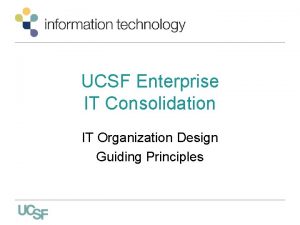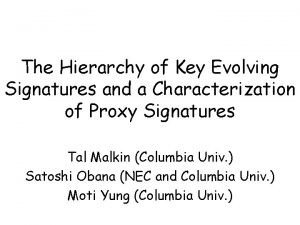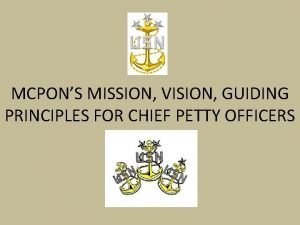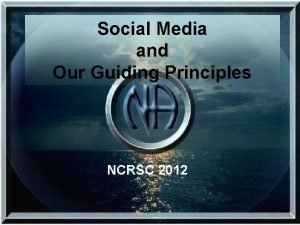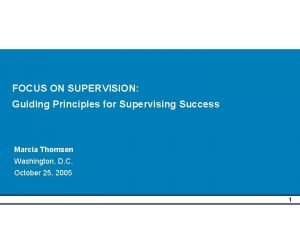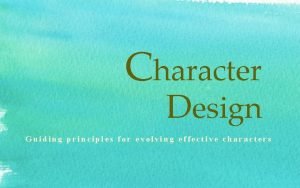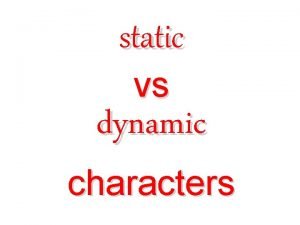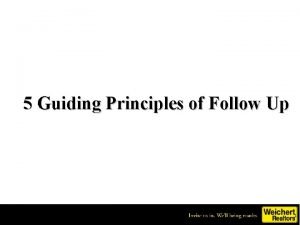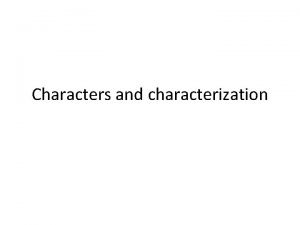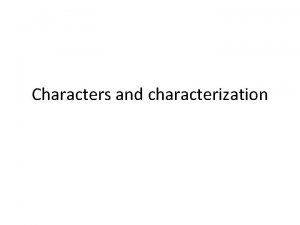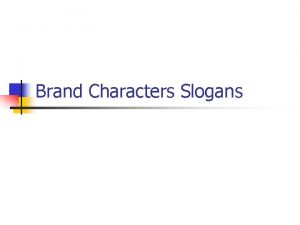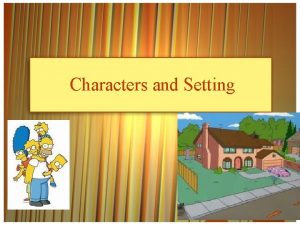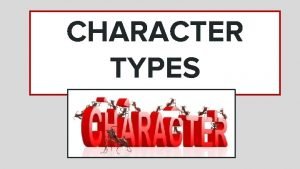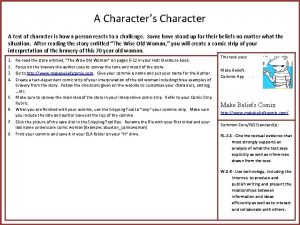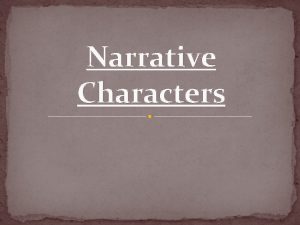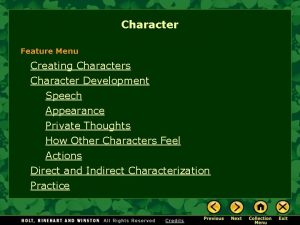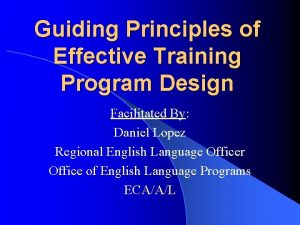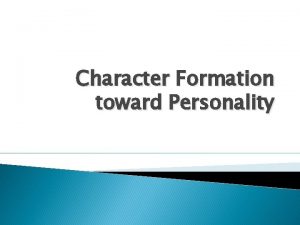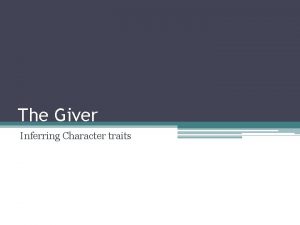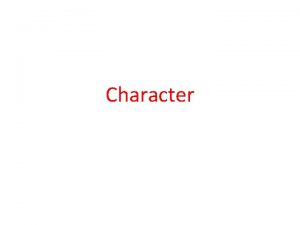Character Design Guiding principles for evolving effective characters






















- Slides: 22

Character Design Guiding principles for evolving effective characters

Design • Creating an effective and interesting character is one of the important aspects that enhance a screenplay. • Structuring the story is very essential but creating effective characters is equally important, as the story is usually based on the actions of the characters in conflict. • If the characters are developed well then the story will seem to naturally rise from their life.

Elements that distinguish an effective major character are Sense of Person • Effective characters convey a sense that they are real people. • They seem to have a personal history and a past that seems to have made who and what they are instead of having been created to meet the requirements of the plot. • They seem to live a life rather than doing what the writer wants them to do. • To achieve this it would be helpful if a writer models his character on real people. If the character is modeled on an existing media character then stereotyping begins and originality is lost.

Elements that distinguish an effective major character are Credibility • Characters should be believable. • Their role must be consistent with who they are, what they know and what the audience knows of them. • Their actions must be consistent to the culture and the setting of the film. Continues……

Elements that distinguish an effective major character are Credibility • Credibility of the story depends on the credibility of the characters in the story. • The characters need to have enough depth and complexities to handle the strong feelings and emotions that are called for by the situations in the film. • Credibility means that the characters respond to a situation with depth and insight that is appropriate to how the audience sees them from how the writer has presented them.

Elements that distinguish an effective major character are Behavior • Film characters are characterized behaviorally by their actions, by what and how they do and say things. • Unlike the novelist the screenwriter has to present the character in specific observable, behavioral ways. • These will include the character’s style of speech, vocabulary, mannerism, dressing and all those other qualities that we use to judge a person’s character.

Elements that distinguish an effective major character are Ambiguity • Effective characters have a certain amount of ambiguity about them. • Not everything about a character should be clear to the audience. • Just as with real people there should be an unknown area in the character where the audience should be able to project their feelings and motivations into the character.

Elements that distinguish an effective major character are Justification • Characters should not be simplistically drawn as “good” or “bad” but as persons who are the result of their past experiences. • There must be a definite reason for who and what they are. • The audience must see that what he does is psychologically - although not necessarily morally – justified. • The most effective villains are not just “bad guys” but are complex individuals acting out of the totality of their being from their past experiences.

Elements that distinguish an effective major character are Motivation • A character’s actions need to have adequate motivation. There should be a reasonable and meaningful “why” behind a character’s objectives and behaviors. • His want and intentions should be based on who he is on the circumstances of the story in which he finds himself. • Motivations are dynamic; they underlie and impel the actions of the character. Continued….

Elements that distinguish an effective major character are • Some motivations would be deep rooted, influencing an entire life course. Other motivations would be situational and could change with the developments of the story. • The pattern of motivation gives consistency and thus justifies the actions of the character. While it is important for the writer to have an understanding of the character’s motivations, this need not be clearly explained to the audience. • Not revealing the motivations could add intrigue and ambiguity to the character.

Elements that distinguish an effective major character are Non-stereotype • It is easy and tempting to create stereotyped characters – oversimplified, one-dimensional, excessively drawn and with certain obvious dominant traits. • They are easily identified copies of other media clichés. It is difficult to create non-stereotype characters, especially for minor characters because they appear for such a short time • . However when we see such real characters we recognize the difference immediately. These observations could be implemented in the clichéd characters just to make them different and more realistic.

Elements that distinguish an effective major character are Strength and Presence • Major characters should be strong enough to sustain the story and the conflict. • Characters must have strong enough presence to get the audience’s interest and involve them through the developments of the story. • Even weak characters need strong portrayal of weakness.

Elements that distinguish an effective major character are Likeability • Characters must be likeable– not in the sense of being glamorous, but having qualities that attract the audience and makes the audience like them. • The audience must care for them as the writer cares for them as he writes. • A writer who does not care about his characters cannot expect the audience to do so. • Once this is lost the character will never hold the interest of the audience.

Elements that distinguish an effective major character are Unique, Individualized: • Effective characters would have their own unique individualized characteristics: actions, speech, movement, rhythm, dress, values, dominant traits and style. • Certain dominant character traits are inevitably empathized over. • It is these aspects that would stand out as we give a description of the character. • They indicate the uniqueness and individuality of the character.

Elements that distinguish an effective major character are Tags • One way to individualize a character is to tag the character with some distinguishing label, mannerism, gesture or other special characteristic of appearance, behavior or speech. • They could be things such as limps, accents, or even a bow tie. • While tag helps to distinguish a character, it should not be over done as it can easily become too gimmicky and turn characters into caricatures and freaks.

Molding a character Establishing Character • Some characters develop slowly; the audience gets to know them progressively. • A writer must give time to the audience to become involved with the character. • However writers usually characterize the principals quickly giving the audience an immediate feeling of involvement with the character.

Molding a character Growth and Change • Characterization is an on-going process. • Just like real life people, characters learn and grow from experiences. They develop as events and interactions with other characters shape them. • There’s always the possibility of some new development, the feeling that there is more to the character that we have seen so far. • This increasingly involves the audience with the character through the length of the film.

Molding a character Conflicting Values • Characters can have conflicting personal values or styles. Internal storylines generally spring from such conflicts. This could show the confused state of mind that the character is in. Character Interactions • Most film stories develop out of the interaction of characters. Interesting relationships are important within the film narrative. The writer needs to know his characters feel about each other and what they want from each other. Continued….

Molding a character • How relationships form and dissolve, grow and change. What of themselves character shares with the other characters and what they hide. • What others know about them that they themselves do not know. What conflicts they clash over. • So much of the film narrative depends on the web of character involvement. • A certain amount of character contrast is valuable for intrinsic interest and to help the audience distinguish between characters. • These may be contrasting values, motives, emotions, temperament, verbal qualities and physical appearance.

Character Biography: • To better understand a character, as well as to give the character a sense of a personal history, a writer can write out a biography for the character. • This serves as a working sketch for the writer. It can help answer questions about a character’s motivations. • It is often useful, quite often exciting, to visualise the complete biography of the character, and not just the period covered in the film.

Character Biography: • That is, it must be clear to the writer what has happened before the character is introduced, and what is going to happen to him/her after the end of the film! • For example, a film might tell the story of a youth. His life spanned in the film may be just two years. • But the writer must be clear about his [pre-film] past life and his future life Such a complete visualising will help the writer bring three-dimensionality to the characters.

h c t e k ? S o t r e w t Ho harac a. C
 Evolving design
Evolving design Org design guiding principles
Org design guiding principles 11 principles of effective character education
11 principles of effective character education A framework for clustering evolving data streams
A framework for clustering evolving data streams Key evolving signature
Key evolving signature Evolving
Evolving Sendai framework guiding principles
Sendai framework guiding principles Wisconsin model early learning standards
Wisconsin model early learning standards Introduction of ncf 2005
Introduction of ncf 2005 The guiding principles for teaching and learning mtb-mle
The guiding principles for teaching and learning mtb-mle Mcpon mvgp
Mcpon mvgp Evolution of eia
Evolution of eia Integration guiding principles
Integration guiding principles Project portfolio management guiding principles
Project portfolio management guiding principles Enterprise architecture alignment
Enterprise architecture alignment Guiding principles for dual language education
Guiding principles for dual language education Ncrsc
Ncrsc Guiding principles of supervision
Guiding principles of supervision Environmental management plan in eia
Environmental management plan in eia Madrid guiding principles
Madrid guiding principles Isms guiding principles
Isms guiding principles Character design principles
Character design principles Example static character
Example static character

